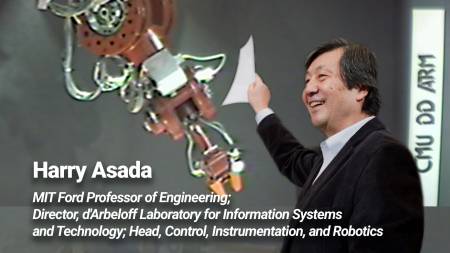
10:30 am to 11:30 am
1305 Newell Simon Hall
In 1980-81 the first Direct-Drive robot was developed at the CMU Robotics Institute. After almost 40 years, Direct-Drive has a renewed interest in the leg robotics community. Robotic legs powered by direct-drive or low gear-reduction motors can better interact with the ground and absorb impacts. In this seminar I will talk about robot design in those early days, focusing on CMU DD Arm 1, followed by two recent trends in robot design. One is a new type of wearable robots, and the other is biological, or live-cell robots, each of them is powered by unique actuators.
• Supernumerary Robotic Limbs, or SuperLimbs for short, are wearable extra arms and legs for augmenting the physical abilities of the wearer. While still a new field, SuperLimbs show promise both as an assistive technology for people with disabilities and as an augmentation technology with various applications, ranging from body bracing during fatiguing works on a floor to assisting people in performing daily chores. SuperLimbs are powered by Dual-Speed, Dual-Motor actuators that can lift a large load as well as move at a high speed.
• Biological Robots are “living” robots including live cells and tissue as components. Engineered muscle cells are used as actuators, neuron cells serve as controllers and sensors, and endothelial cells form a vascular network for delivering nutrients and oxygen. Recently, vascularized muscle actuators have been developed in an in vitro environment, and engineered skeletal muscle actuators have been controlled with optical signals using optogenetics. In the near future, these biological robots will deliver drugs to our organs and repair our body.
With these design examples, I will address the importance and challenges of novel actuators that open up new possibilities of robotics.
Biography:
H. Harry Asada is Ford Professor of Mechanical Engineering and Director of the Brit and Alex d’Arbeloff Laboratory for Information Systems and Technology in the Department of Mechanical Engineering, Massachusetts Institute of Technology (MIT), Cambridge, MA. He specializes in robotics, biological engineering, and system dynamics and control. His current robotics research includes wearable extra limbs, plant-like growing robots, aircraft manufacturing robots, autonomous excavators, and workforce training robots. His research in the bio area focuses on bio-integrated robots, where live cells and tissues are used as components. He received Best Paper Awards at the IEEE International Conference on Robotics and Automation (ICRA) in 1993, 1997, 1999, and 2010, the O. Hugo Schuck Best Paper Award from the American Control Council in 1985, and other 8 best paper awards at major journals and conferences. He was the recipient of the Henry Paynter Outstanding Researcher Award from ASME Dynamic Systems and Control in 1998. More recently he received the 2011 Rufus Oldenburger Medal from ASME, and Ruth and Joel Spira Award for Distinguished Teaching from School of Engineering, MIT. He is a fellow of ASME.
